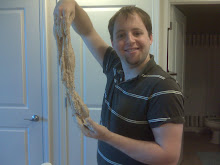Have you ever messed up a fried egg and tried to immediately scramble it in the pan in an attempt to save it? Well I sure have, and the supposedly scrambled egg usually just looks like an ugly slaying of a messed-up egg. Not delicate. Not fluffy. Not moist. Nothing like a real scrambled egg. This is probably the best illustration for why The Scrambled is such a marvelous style of cooking eggs. Seemingly "random" steps lead to a beautiful transformation, while seemingly logical steps (literally scrambling an egg) leave you with a far uglier non-transformed outcome. Scrambled eggs are a simple egg to master, but it would never happen in a million years with only logic by your side.
So how to make this moist, fluffy egg style that barely resembles the egg it started as, nor tastes like the egg styles that do resemble the original? You need a pan, a bowl, a spoon, a spatula, milk and eggs. That's it. I would recommend scrambling two eggs per person in a small to medium pan, only graduating to a really large pan after 6 eggs. Crack all of your eggs into the bowl and add about a tablespoon of low fat or nonfat milk per egg. I usually just eyeball the milk, which probably isn't the best thing, but it is always best to air on the side of less milk than more. Scrambled eggs with too much milk are not pretty. Also, I actually think scrambled eggs with lower fat milk come out fluffier and moister than scrambled eggs with higher fat milk. I have no idea why, but it makes it even easier to reduce the fat in the dish.
Anyway, once you have your eggs and milk, beat 'em! Don't whisk 'em. Don't stir 'em. Beat 'em! This means taking your spoon and vigorously stirring from the center of the mixture, so that it almost appears as if the whole mixture is attached to the spoon as it spins around it. Beat those eggs until the mixture is uniformly yellow. Also, by this time you want to have heated your pan. I almost always put the pan on medium at the most, sometimes a little bit less. You do not want those eggs to cook to fast or they will come out funky and possibly dry or burned. Also, as is my credo with nearly all forms of eggs, fat in the pan is not necessary to make amazing scrambled eggs. Just spray a little nonfat cooking spray once the pan is warm. If you're using a nonstick pan, you probably don't even need that.
So once your pan is ready and your eggs are ready, pour the entire mixture into the pan. I like to immediately and gently stir the eggs with the spatula. I then wait about 15 seconds before again gently stirring the eggs with the spatula. I then wait another 15 seconds and continue the cycle of waiting and then gently stirring the eggs. This will allow you to fold the cooked egg over the egg mixture as parts of the eggs cooks. This is vital to getting the eggs to cook in that delicate, fluffy and moist way. Keep doing this until the eggs are almost completely solid (95% done), but don't wait until the eggs are all solid. The eggs will continue to cook a little after you take them off the heat, so taking them out a few seconds early will make them perfect when you serve them. If you take them off the heat once they are completely done (or even later) then they may be denser or dryer when you eat them. If you want to add mix-ins like cheese or scallions or mushrooms, it is best to put the ingredients in just before the eggs are almost done. Wait until the eggs are 80% done and then mix everything in and continue cooking until that 95% mark when they should be fluffy and nearly-finished. Salt and pepper at the end.
Enjoy your scrambled eggs with toast, bagel or even over a salad or in pasta! You will love your perfect scrambleds, despite how disparate their cooking method is from their name. And the next time you mess up a fried egg, you'll just leave it alone, rather than disparage The Scrambled.
This is the 5th entry in the Egg School series. Catch my past entries on Over Easy, Sunny Side Up, Poached and Baked Eggs. Stay tuned for Hard Boiled, Soft Boiled, Omelet, Fritatta and Souffle in the coming days and weeks.






No comments:
Post a Comment